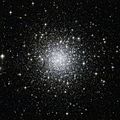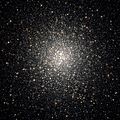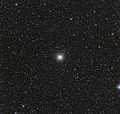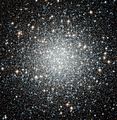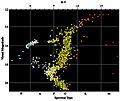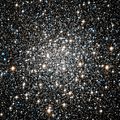Globular cluster facts for kids
A globular cluster is a huge group of stars that are all about the same age. These clusters often orbit the center of a galaxy, like our own Milky Way. Gravity is what holds these clusters tightly together, giving them their round, spherical shape. If you could visit the center of a globular cluster, you'd see tons of stars packed very closely together!
Globular clusters can be found in different parts of a galaxy. Some are in the galaxy's "halo," which is like a big, faint cloud around the main part. These halo clusters are usually very old and have many, many stars. Others are in the galaxy's "disk," which is the flatter, main part where most stars are. These disk clusters are usually younger and not as dense.
Our Milky Way galaxy has about 150 to 158 known globular clusters. Bigger galaxies can have even more! For example, the Andromeda galaxy might have as many as 500. Some giant elliptical galaxies, which are shaped like stretched-out balls, can have thousands of globular clusters. For instance, M87 has around 13,000! These clusters orbit their galaxy very far out, sometimes more than 131,000 light-years away.
Almost every large galaxy we've looked at has its own set of globular clusters. Even smaller galaxies, like the Sagittarius Dwarf and Canis Major Dwarf galaxies, seem to be "donating" their globular clusters to the Milky Way as they get closer. This shows how our galaxy might have collected some of its clusters over a very long time.
Discovering Globular Clusters
| Cluster name | Found by | Year |
|---|---|---|
| M22 | Abraham Ihle | 1665 |
| ω Cen | Edmond Halley | 1677 |
| M5 | Gottfried Kirch | 1702 |
| M13 | Edmond Halley | 1714 |
| M71 | Philippe Loys de Chéseaux | 1745 |
| M4 | Philippe Loys de Chéseaux | 1746 |
| M15 | Jean-Dominique Maraldi | 1746 |
| M2 | Jean-Dominique Maraldi | 1746 |
The very first globular cluster ever found was M22 in 1665. But it wasn't until Charles Messier looked at M4 that astronomers could actually see individual stars within a globular cluster. The table on the right shows the first eight globular clusters that were discovered. The "M" before a number means it's from Charles Messier's list, and "NGC" comes from the New General Catalogue.
In 1782, William Herschel started using bigger telescopes to study the sky. He was able to see the individual stars in all 33 globular clusters known at the time. He also found 37 more! In 1789, Herschel was the first person to use the name globular cluster to describe these amazing groups of stars.
Over time, more and more globular clusters were found. By 1915, there were 83 known. By 1947, that number grew to 97. Today, we've discovered 152 globular clusters in our Milky Way galaxy. Scientists think there might be about 180 in total, with some still hidden behind the gas and dust in our galaxy.
Images for kids
-
Globular star cluster Messier 54
-
Messier 10 is about 15,000 light-years from Earth, in the constellation of Ophiuchus.
See also
 In Spanish: Cúmulo globular para niños
In Spanish: Cúmulo globular para niños


